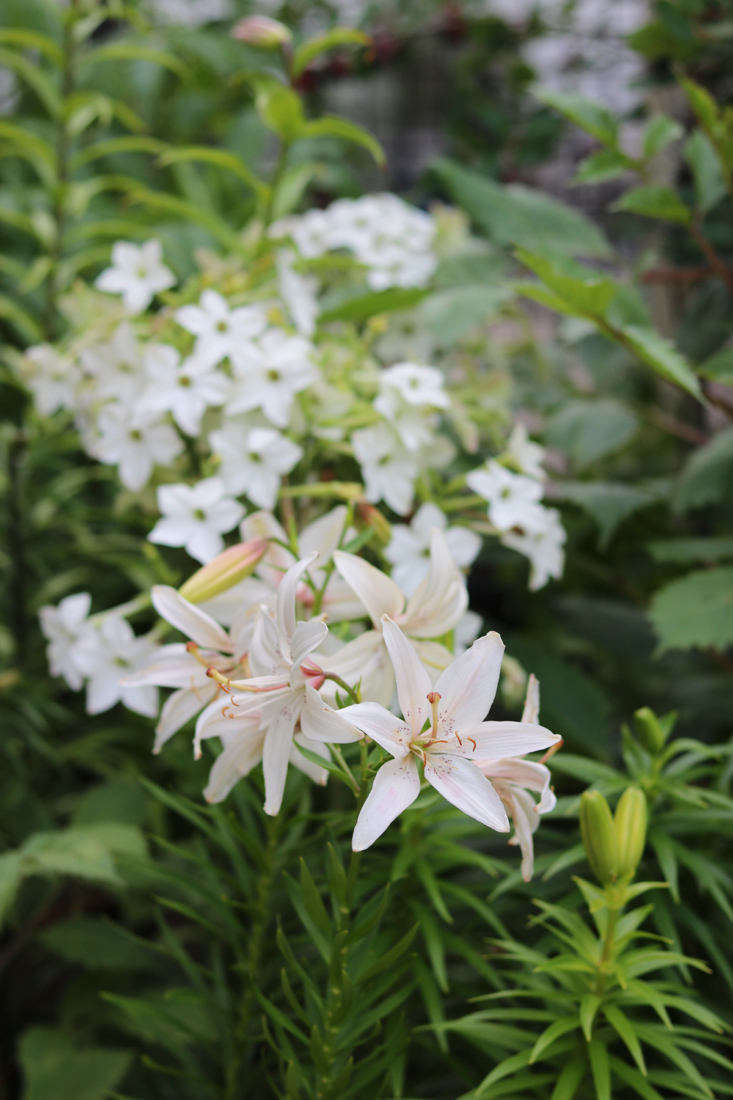Our 1,000-square-foot backyard garden in the Brooklyn neighborhood of Carroll Gardens is now in its third summer. But by the end of September we must move, and I must decide what plants come with us when we go. This will be our fourth move with a garden in tow. The nature of rental real estate is such that you can’t plan too far in advance, generally signing a lease within 30 days of the move date. So while we are actively looking, we do not yet know where we are going to live. Will the new garden space be sunny or shady? Big or tiny? In-ground or on a rooftop? I have plants to fit every scenario. Way too many plants. And no plant will be left behind.
To make lemonade out of this batch of lemons (actually, I like lemons), I am planning to throw an August plant adoption party for the pots and plants that don’t make the cut. There will be botanical cocktails, there will be fond farewells. I won’t cry.
Here’s a visit to the summer garden. It looks a lot different from when we moved in.
Photography by Marie Viljoen.

Beyond it, the side borders and vegetable garden are rambunctious. Quite apart from gardening for pleasure (and therapy), I grow some more unusual edible plants experimentally, for the first-hand experience I need when advising others to cultivate them. How does common milkweed behave? What about nettles? Are ramps impossible to cultivate? Can you grow your own fiddleheads? (You will find the answers in Forage, Harvest, Feast, my new wild foods cookbook.)

It took me at least a year to figure it all out. These pots see about six hours of sun a day from late spring to late summer (none in fall and winter) and the mix that thrives right now includes pineapples lilies (Eucomis species), calamintha, dahlias, lilies, and flowering tobacco.

That’s a very good return on investment. Pollinators love them. In five hours of summer sun this collection of pots includes perilla, purple basil (which appreciates some relief from hot sun), and stalwart begonias. Last winter some of the potted pineapple lily bulbs rotted, despite being technically hardy here (USDA zone 7b). Pots are extreme environments and the freeze-thaw cycle in them is far more brutal than for the same plants in-ground, just a few yards away. The bulbs stored in the fridge’s crisper drawer were fine. Left in their pots, a chilly basement would be ideal.
Above: Lilium ‘White Butterflies’ is $15 per bulb at the Lily Garden.
Lilies have bloomed in all my New York gardens. They take well to containers, and different types offer a sequence of bloom from late spring to late summer.

I garden organically, without herbicides or pesticides and the reward is a host of hoverflies, lacewings, ladybugs, many kinds of bees, and butterflies (somehow, I never see the caterpillars…). The shrubs include native arrowwood viburnum (Viburnum dentatum), elderberries and serviceberry (Amelanchier alnifolia) and are planted in terra cotta pots 18 inches in diameter.

The lilies include statuesque ‘Silk Road’ and ‘Ice Palace’. Between them swamp milkweed (Asclepias incarnata) is a magnet for bees and butterflies. Liatris, cleome and daylilies share the space.


Edible plants: In winter my Thai limes (Citrus hystrix) overwinter indoors in a sunny room, along with a Meyer lemon, a finger lime, pots of curry leaf trees, and cardamom.

The flowers are strikingly beautiful, richly scented, and filled with nectar. And monarch butterfly larvae feed on milkweed leaves. It grows aggressively, which is why it is often viewed as a weed, but I control it by simply pulling up the shoots that pop up where they are not wanted.


Milkweed dislikes being transplanted so adopting these ones out will be a challenge, even though they are in high demand. The good news is that even if the plants’ leaves wither and fall soon after transplanting, the underground runners will still be at work, and will survive to appear next spring. This is not a good candidate for a potted garden, because those runners really like to, well, run. (Try swamp milkweed, instead.)


Myogo ginger and so-called Vietnamese cilantro (Persicaria odorata) thrive. Prickly ash grows here, too – Zanthoxylum americanum is the American species of Sichuan pepper.

Giant dragonflies zoom high above us, like a squadron miniaturized drones, performing crazed maneuvers in pursuit of their prey: mosquitoes. We cheer. Above the rooftops, chimney swifts chatter as they catch insects and talk with their beaks full. If we are very lucky, we see a neighborhood possum, walking along the wires strung between buildings (since opossums love to eat ticks and do not carry rabies, we are fans. Also, we think they they are cute.)
The uncertainty of a move is stressful, but I have to remind myself that I have done this before, and I can do it again. But we feel our migratory rental lives are coming to an end. This will be the last move to a place we do not own. It is time to put down real roots.
Where will the next garden be? Which plants will stay and which will be adopted?
If you stick around, you may find out…














Have a Question or Comment About This Post?
Join the conversation